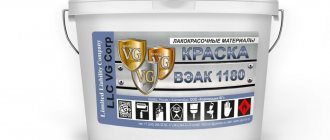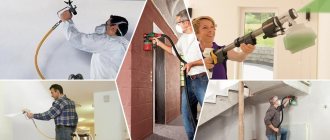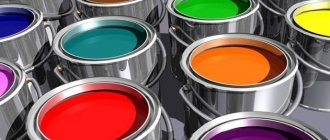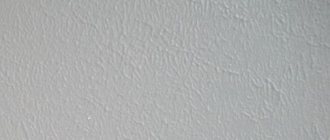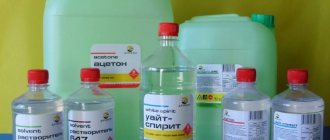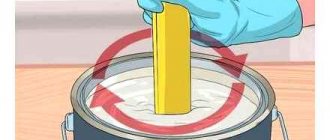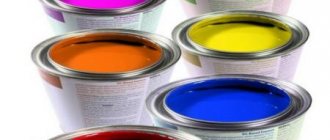All construction materials of any significance necessarily fall into GOST standards. This is both a guide to action and a sign of respect and recognition of merit. Technical characteristics of water-based paint according to GOST are a whole list of requirements for the final product, which are a guide to action for manufacturers.
For the most part, these characteristics do not mean anything to an ordinary painter, but the compliance of the purchased material with them helps to be confident in its quality.
GOST for water-based paint also determines the recommended colors of the finishing material
When government standards fail to keep pace with “initiatives from below”
Technical characteristics of water-based acrylic paint vary depending on the place of its application - on the facade or in the interior
The first parameters of the presented material were presented in 1980 by GOST 19214-80. Nine years later, a new edition of the standards was released, which clarified and changed some of the provisions of the first edition.
What's in GOST
The standard defines:
- external characteristics of the material - its color and appearance after drying;
- internal – the proportion of non-volatile substances and acidity;
- application indicators – consumption, degree of grinding, drying time;
- basics for making each type of finishing paint;
- safety precautions when using;
- acceptance rules , which are of a purely practical final nature, based on the results of using samples on rough working surfaces of various types;
- test methods - at least a third of the entire volume of the document is devoted to this in the standards;
- transportation and storage rules.
The instructions do not specify a tool for working with the described paint, but it is generally accepted that the roller is unrivaled
Colors and numbers
The color of the paint is determined not by its liquid state in the can, but by the color of the film frozen on the surface.
Thus, water-based paint according to GOST 19214 80 can have 10 colors:
- white;
- white – a shade of white night;
- Ivory;
- light beige;
- light yellow;
- orange-beige;
- citric;
- pale olive;
- pale pistachio;
- pale turquoise.
After 30 years, it is impossible to say why these 10 colors were chosen to be mentioned in the standard, but it does not really matter. The colors are indicative only; over the past 20 years, the color palette of the material in question has grown many times over.
However, analysis of the initial colors allows us to conclude that these paints are not particularly bright after drying; pale and lemon tones predominate among the colors. (See also the article How to tint paint: features.)
This paint is often also called water-dispersion paint, despite the 50% composition of water, after applying it with your own hands and drying it really becomes moisture resistant
Among the digital internal paint parameters, we highlight three:
- mass fraction of non-volatile substances (%) - this indicator affects the consistency of the paint and the speed of its drying, depending on the type of paint it is:
- VD-VA-27A (belongs to the highest quality category) - from 52 to 57;
- VD-KCh-26A (first category) – from 52 to 57;
- VD-KCH-26 (also the first) - from 58 to 65;
- acidity is the pH factor so known from perfumery, it should be:
- VD-VA-27A – from 6.5 to 8.2;
- for CC – more than 9.
- conditional viscosity, which must strictly be measured at an ambient temperature of 19.5 - 20.5 degrees, while the nozzle of the measuring device (viscometer) must have a diameter of 5.4 mm:
- for all types – 20.
OKPD for water-based paint also stipulates its recommended consumption, but it strongly depends even on the size of the pile of the roller nozzle
Paints vd nts 240 technical characteristics
Polymethylacrylate latex. 1.0
Sodium polyacrylate (12-15% solution). 0.006
Ammonia water. 0.02
Chalk or chalk paste. 2.0—3.0
Water (until working consistency). 0.5—1.0
Add sodium polyacrylate and ammonia water to the chalk paste and mix everything thoroughly. Mix the resulting composition with latex and then grind it in a baking tray with a spatula, adding water if necessary and bringing the putty to a working consistency.
Waterborne glypthal emulsion paints
(suspension of pigments in glyphthalic emulsion) are produced by industry and are used in finishing work, both in interiors and exteriors. The paints have high adhesion to concrete, plaster, stone, brick, wood, metal and other materials. They form a matte or slightly glossy elastic paint layer with good weather resistance (40).
All preparation of walls for working on them with water-borne glyptal emulsion paints is identical to the preparation of surfaces for oil paints (see section VIII “Oil paints”).
Water-borne emulsion paints STEM-45
(pigmented aqueous emulsion of styrene copolymer and sunflower or cottonseed oil). Paints are produced by industry and used in finishing work in building interiors. They work on concrete, wood, brick, plaster, etc. The paints form a colorful layer with a slight sheen to the surface, which can be washed with soap (40. P. 110-111).
All preparation of walls for working on them with water-borne emulsion paints STEM-45 is identical to the preparation of surfaces for oil paints (see section VIII “Oil paints”).
Emulsion paints SEM.
They are produced by industry in 11 colors; they are a suspension of pigments in an emulsion of glyphthalic varnish (type VM) with the addition of a drier. The paints are diluted to a working consistency with solvent, white spirit, and turpentine. The paints can be used indoors on concrete, plaster, wood and other similar materials; they form a colorful layer with a slight sheen to the surface.
Surfaces for SEM emulsion paints are prepared in the same way as for oil paints (see section VIII “Oil paints”) (40. P. 110).
All water-dispersion and emulsion paints that the industry produces for various types of finishing work can also be used in mural painting, tinted in accordance with the sketch. You can also rub the paints, similar to industrial ones, on a binder of one or another composition yourself. To do this you need to have a binder and pigments.
When working, you should not mix paints with different binders. For example, polyvinyl acetate with emulsion and others.
Since the 60s, work has been intensively carried out in our country to create paints based on a composite binder, a binder not based on any one dispersion or latex, but on a mixture of two or more dispersions, latexes and resins. Such mixtures make it possible to obtain paint layers with higher technological indicators in terms of strength, weather resistance, light resistance and water resistance (42. P. 20)[221].
Much work in this direction is being carried out by the Leningrad NPO Pigment, which has developed a whole range of such binders and paints based on them. The compositional binder of these paints provided them with such high technological characteristics that it would be unjustified frivolity not to be interested in them from the point of view of using them in mural painting. These paints were created for finishing work in construction and industry, therefore, a set of paints of certain colors is very rarely produced using one or another binder, more often paint of the same color with a very specific area of application.
Practical indicators
For the most part, internal indicators do not provide any significant information for the contractor. When working, pay more attention to the application parameters.
Application options
Application parameters include:
- first of all, the most important is consumption or coverage (g per sq.m); it is calculated based on the already dried film and depends not only on the type of paint, but also on its color; So white can have three types of coverage:
- VD-VA-27A – 120;
- VD-KCH-26A – 140;
- VD-KCH-26 – 220 (we advise you to pay attention to this jump);
- for the “white night” these figures are noticeably lower:
- VD-VA-27A – 80;
- VD-KCH-26A – 80;
- VD-KCH-26 – 110;
- for pale olive:
- VD-VA-27A - 70 - this is the lowest among all types and colors;
- VD-KCH-26A – 70;
- VD-KCH-26 – 130;
- the next most important indicator is drying time, which greatly depends on the ambient temperature and its humidity; for all types of paint at temperatures from 18 to 22 degrees and humidity not higher than 80%, this indicator up to the 3rd degree of drying (non-stick) does not exceed an hour;
- A very useful indicator is the washability of the material, measured in grams per square meter - it does not exceed 3 for the highest category, and 4 for the first.
The composition of the work when painting with water-based compositions contains two mandatory points - the first pass with a thick consistency and the second with a more liquid consistency, then there will be no such stains as in the photo
Conditions of use and storage
The standards separately stipulate the state of the external environment when working with these paints:
- firstly, they must withstand frost temperatures down to -40 degrees;
- Moreover, thawing should occur without any visible changes to the painted surface;
- secondly, if the paint requires dilution before use, this should only be done with water with a hardness of no higher than 3 mg, and the viscosity before use should be:
- if a roller is used to apply paint - from 30 to 40;
- if the brush is from 40 to 50;
- if the spray gun is from 20 to 25.
- thirdly, it is specifically stipulated that the paint is fire and explosion-proof, however, it requires the use of personal protective equipment when applied; it is unacceptable to get it on open areas of the skin, in the respiratory tract and eyes;
- fourthly, working with paint requires constant ventilation of the workspace; it is unacceptable to exceed in the surrounding space (g per cubic meter):
- gasoline – above 300;
- styrene – 5;
- vinyl acetate – 10.
The production of water-based paint strictly stipulates two options for its use - for ceilings or for walls.
The following restrictions apply to storage conditions:
- it should not be carried out at negative external temperatures;
- transportation of paint can be carried out even in frosty conditions, but the period should not exceed one month;
- water-based paint in accordance with GOST 28196 89 has a guaranteed shelf life of no more than 6 months.
Helpful advice! We advise you to pay attention to such special clauses of the standards that determine the procedure for controlling the quality of the applied coating. One of the most interesting control methods is determining paint washability. The procedure is carried out using a toothbrush and a stopwatch.
The shelf life of water-based paint depends on its storage conditions, but you shouldn’t tease the geese, it’s better to completely use up the entire open container, so calculation, and calculation again
Features of application technology
Nitroenamel is a toxic compound. She keeps the fire burning. Therefore, painting is carried out in a ventilated area, fire safety precautions are observed, and personal protective equipment (respirator, gloves) is worn.
- Using special solvents and washes, the old layer of enamel is removed from the surface. Rust and dirt are removed from metal;
- the dried metal surface is primed: VL (VL-023 primer for metal 40 kg + 8 kg acid thinner – 200 rubles); FL-03K (138 rubles per kg); GF-021 (86 rubles per kg); PF-020 (100 rubles per kg); GF-032GS (105 rubles per kg).
Enamel, diluted in a 5:1 ratio with a solvent, is used as a primer: No. 646 for grade NTs-132P and No. 649 for grade “K.”
- The surface of ferrous metals is not primed before painting.
- The jar is opened, the mass is mixed, the film is removed, and the viscosity of the composition is established. Working viscosity according to VZ-4: for NTs-132K 30-60 s, diluted with solvent 649; for marking “P” 18-20 s, solvent 646 is used.
- A two-layer enamel coating is applied. The second time the product is coated with enamel after 2-3 hours.
- After 24 hours, the dried enamel can be polished so that the layer acquires a glossy shine.
Terminology and composition
First of all, it must be said that there is nothing in common between enamel and paints and varnishes. Enamel is a glassy formation that includes quartz, alkali metal oxides, pigments and other components. After application to the base, these components are thermally treated, resulting in a very durable, wear-resistant protective layer. Unlike paints, which are applied to the surface of the product, enamels are fused. Examples of the use of enamel include enamel cookware, enamel-coated bathtubs, some types of ceramics, etc.
Paint is a broader concept than enamel paint composition. The first enamel paint and varnish compositions appeared after chemists learned to modify pentaphthalic drying oil with alkyd resins. Unlike enamel composition, ordinary paint and varnish material is made on the basis of linseed oil (natural drying oil) brought to a boil. The difference in composition is noticeable even in the markings: on cans of enamel paints there is always the abbreviation PF (pentaphthalic), but simple paints contain the MA (oil) index. Enamel paint differs from ordinary paint in its smoother and more durable coating.
Enamel paint is liquid or paste pigments, the medium of which is a solution of film formers in organic solvents. A varnish, alkyd resin or other substance with similar physical and chemical characteristics is usually used as a film former. When the enamel paint and varnish material dries, an opaque film remains on the surface, differing in different cases both in color and texture.
As for the gloss of the coating, this indicator depends not only on the film former, but also on the additives included in the paintwork materials, and therefore some ordinary paints shine much more intensely than enamel paints.
It is worth mentioning such a characteristic feature of the enamel composition as a pungent odor. For ordinary paints, an unpleasant strong odor is not at all necessary, especially if they are water-based: the odor may be absent, weak or even aromatized.
Despite the above, it should be noted that enamel paints are not always the best choice. The advisability of using enamel paints and varnishes depends on specific circumstances. For example, if the best choice for wooden window frames is alkyd enamel paint, then for a park bench it is better to opt for polyurethane paint and varnish.
With hardness and elasticity, the situation is more clear: enamel coatings are stronger. It should also be noted that enamels are highly resistant to moisture compared to conventional paints, which swell and crack when exposed to moisture.
Enamel paints are a relatively small segment of paints and varnishes, in which the compositions are characterized by high strength and opacity. Enamels are especially often used in industry when it is necessary to prevent the development of corrosive processes.
Application rules
Depending on the type of enamel chosen, a spray bottle or brush is used. Apply the mixture with smooth, leisurely movements.
After applying the first layer, it is important to wait about 2-3 hours, after which it is advisable to apply another layer. When the second layer is completely dry, you can polish the surface
Since this enamel contains organic solvents, it is flammable, so it should not be applied near open flames or sparks. Paint fumes are toxic, therefore, if painting is done in a room, it must be ventilated both during the work and for several hours after painting is completed. You should work with gloves and goggles to prevent the mixture from getting into your eyes and skin. After finishing dyeing, wash your face and hands thoroughly.
Domestic manufacturers of finishing materials offer us a huge range of products that are used for protective and decorative treatment of internal and external surfaces. Construction sites are overflowing with various varnishes, impregnations, paints, enamels and other coatings. One of the first places in popularity is occupied by the composition NTs-132, an enamel designed to protect metal and wood products.
What are the main properties of this product, what are its features and how to work correctly with such a composition, we will consider in this article.
